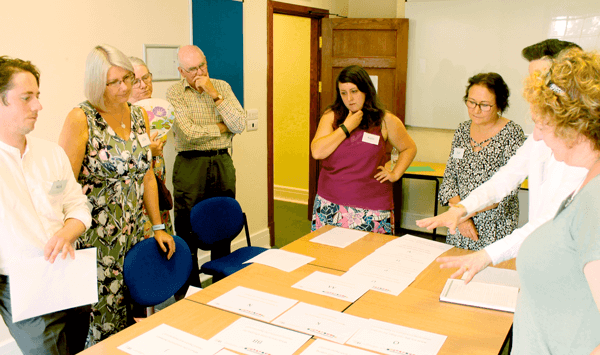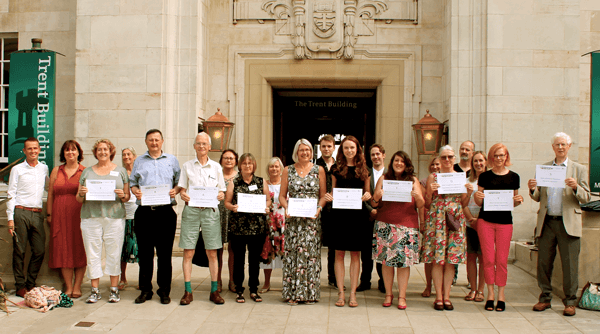An innovative and inclusive approach to the identification and prioritisation of research questions is to place the views of patients at the heart of the process, and in partnership with clinicians. The application of this to hyperacusis is described by Drs Hoare and Fackrell.
Hyperacusis is a condition involving a reduced tolerance or increased sensitivity to sounds, whereby everyday sounds become intense and overwhelming. Despite being common, there has been very little research to date. Priority research questions have not been identified using a democratic process driven by patients and clinicians.
Small group discussion. Stakeholders agree a set of priorities.
Why is hyperacusis a problem?
Hyperacusis occurs as a primary complaint but is also commonly associated with other conditions including tinnitus, head trauma, depression, post-traumatic stress syndrome, and fibromyalgia. Available estimates suggest hyperacusis is experienced by 3.7% of children, and up to 9.2% of adults in a general population. Prevalence is much higher in certain populations, such as those who have Williams’ syndrome or autism [1]. Problems associated with the lived experience of hyperacusis are many, and affect both the individual and their family or carers. Tyler and colleagues proposed a framework for categorising hyperacusis based on the defining feature of their experience, suggesting loudness, annoyance, fear, and pain are important characteristics [2].
“Available estimates suggest hyperacusis is experienced by 3.7% of children, and up to 9.2% of adults in a general population.”
In a subsequent cohort study involving 355 adult patients, 35 distinct domains of hyperacusis-associated problems were identified, including fear, pain, avoidance behaviours, and impairments to quality of life, such as reduced ability to work [3]. For children who have hyperacusis, the classroom can be a very challenging place, and strategies need to be in place to ensure that their wellbeing and educational needs are met. For many, living with hyperacusis can be very isolating. Everyday settings, including healthcare settings can be too challenging for people to face. It’s not surprising then that many thousands of people turn to Facebook and other social media to seek out information and support.
How is it managed currently?
Clinical management of hyperacusis includes non-standardised assessment using sound-based tolerance tests, and questionnaires to determine and measure the impact it has on an individual’s life [4]. Approaches to treatment include sound therapy, e.g. use of sound generators to desensitise patients to sound, and cognitive behaviour therapy (CBT) to challenge negative thoughts and safety behaviour. However, there are no formal clinical practice guidelines available so treatment decisions rely on clinical expertise, and what is determined as individual patient needs and preferences [5].
Concensus. The Top 10 priorities are agreed.
Working together to identify priorities
The Hyperacusis Priority Setting Partnership (PSP) was formed to identify a set of priority questions about hyperacusis that are most important to patients, and healthcare practitioners involved in the care of adults and children who have hyperacusis. The project followed methods established by the James Lind Alliance in which people with lived experience and healthcare professionals agreed a shortlist of questions that are considered priorities for research in the UK. A PSP was established that included people with lived experience of hyperacusis (patients and parents), adult and paediatric healthcare practitioners (clinical and cognitive psychology, audiology, ear nose and throat and audiovestibular medicine), researchers, and representatives from organisations involved in supporting people with hyperacusis, (Hyperacusis Support & Research Facebook group), funding hearing research (Action on Hearing Loss), and communicating science (Cochrane UK). The whole process was chaired and facilitated by expert advisors from the James Lind Alliance.
The process
Priority setting was carried out using data from online surveys, online voting, and a facilitated workshop with equal numbers of people with lived experience of hyperacusis and healthcare professionals. In the first survey, 312 respondents worldwide submitted 2370 research questions (termed ‘uncertainties’). Of these respondents, 179 (57%) were people with lived experience, and 86 (28%) were healthcare professionals, one of whom also had hyperacusis. Thirty-eight respondents (12%) did not belong to either category; this included parents, carers, family members, friends, and teachers.
“People with lived experience and healthcare professionals agreed a shortlist of questions that are considered priorities for research in the UK.”
So what are the priorities?
Firstly, submitted questions had to be verified as truly ‘unanswered’ by thoroughly checking all available research literature on hyperacusis. The steering group then organised and grouped the unanswered questions according to similarity, creating a list of 85 which were used in the second survey. In the second survey, participants voted for their individual 10 priority questions from the list of 85. A total of 327 participants voted in the second survey. From the 28 uncertainties that received the most representative votes, the following 10 research priorities were agreed during a final workshop involving 21 participants, held in Nottingham, UK, in July 2018.
- What is the most effective treatment approach for hyperacusis in children?
- What is the prevalence of hyperacusis in a general population and other specific populations (e.g. people with autism, mental health issues, learning disabilities, hearing loss)?
- Are there different meaningful types of hyperacusis?
- What is the essential knowledge/training required for health professionals to appropriately refer or effectively manage hyperacusis?
- Which treatment approaches are most effective for different types or severities of hyperacusis?
- Is hyperacusis due to physical or psychological issues or is it a combination of both?
- Which psychological therapy (e.g. counselling, cognitive behavioural therapy, mindfulness) is most effective for hyperacusis?
- What management approach for hyperacusis is most effective for adults/children with autism?
- What is the best way of using sound in therapy for hyperacusis?
- Which self-help interventions are effective for hyperacusis?
References
1. Fackrell K, Potgieter I, Shekhawat GS, et al. Clinical interventions for hyperacusis in adults: a scoping review to assess the current position and determine priorities for research. BioMed Research International 2017. Article ID 2723715.
2. Tyler RS, Pienkowski M, Roncancio E. A review of hyperacusis and future directions: part I. Definitions and manifestations. American Journal of Audiology 2014;23(4):402-19.
3. Fackrell K, Sereda M, Sheldrake J, Hoare DJ. Untangling the relationship between tinnitus and hyperacusis: What are the problems reported by patients with a primary complaint of hyperacusis. Proceedings of the 11th Tinnitus Research Initiative conference. March 2018, Germany.
4. Fackrell K, Hoare DJ. Scales and questionnaires for decreased sound tolerance. In: Baguley D, Fagelson M, (Eds.). Hyperacusis and Disorders of Sound Intolerance: Clinical and Research Perspectives. San Diego, USA; Plural Publishing Inc; 2019.
5. Baguley DM, Hoare DJ. Hyperacusis: major research questions. HNO 2018;66(5):358-63.
SUMMARY
-
Despite hyperacusis being a major problem for so many children and adults, and increasing interest and publication in the field, little investment has yet been made in hyperacusis research.
-
There is now a set of priority questions that provide a new and important platform for researchers and those who fund research to ensure that future research activity focuses on questions that are important to people with lived experience of hyperacusis, and to healthcare practitioners involved in their care.
-
The ‘Top 10’ research priorities for hyperacusis focus on important aspects of treatment, cause, mechanism, prevalence, and healthcare provider knowledge and training.
Declaration of Competing Interests:
This work was supported by funding provided by the British Society of Audiology and Action on Hearing Loss. DJH and KF are funded by the National Institute for Health Research (NIHR) Biomedical Research Centre programme, and Post-Doctoral Fellowship respectively. However the views expressed as those of the authors and not necessarily those of the NIHR, the NHS or the Department of Health and Social Care.









